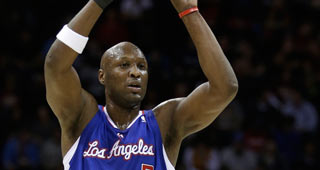With the season underway and Lamar Odom nowhere near a roster, his NBA career appears all but over. Even without his numerous off-court issues, at 34 and more than two years removed from being an effective player, Odom would have been in an uphill battle to get back in the league. If this is it, he leaves behind a complicated legacy in the sport. However, the player he could have been shouldn’t detract from the incredible player that he was.
Talent was never the issue for Odom. At 6’10 235 with a 7’4 wingspan, he had the length of a center and the quickness of a small forward. He was the prototype for a new generation of big men, more comfortable on the perimeter than the low block, but what made him special was his feel for the game. Not only could he handle and pass like a guard, he could control tempo and create shots for anyone on the floor. There really wasn’t much he couldn’t do on a basketball court.
Odom first came on NBA radar screens as a high schooler in New York City, a 6’9 point guard who led his team to a state title. Like many in the city’s AAU scene, his recruiting got a little messy, a pattern that would follow him through the rest of his career. He committed to UNLV before eventually winding up at Rhode Island, where he had to sit out a year. In his only season in college, he averaged 18 points, eight rebounds, four assists and 1.5 blocks on 48 percent shooting.
His game instantly translated to the next level. As a 20-year-old rookie with the Los Angeles Clippers, Odom averaged 17 points, eight rebounds and four assists on 44 percent shooting. Those Clippers were a great what-if team, eventually featuring Odom, Elton Brand, Andre Miller and Quentin Richardson. In 2003, they allowed Odom to sign as a restricted free agent with the Miami Heat, where he teamed up with Dwyane Wade and Caron Butler to reach the second round of the playoffs.
He really started to come into his own with the Los Angeles Lakers, who picked him up as part of the Shaquille O'Neal trade. Odom averaged the first double-double (15 and 10) of his career in 2005; he was more efficient on offense and more reliable on defense. Nevertheless, there wasn’t enough talent around him and Kobe Bryant to contend. With Odom as their second-best player, the Lakers lost first-round series to the Phoenix Suns in 2006 and 2007.
Everything changed in 2008, when they stunned the NBA with a mid-season trade for Pau Gasol. All of a sudden, with Odom as their third-best player and second-best big man, the Lakers couldn’t be stopped. With the offense running through Gasol and Kobe, Odom no longer had to look for his own shot. He was the ultimate glue guy, a 6’10 jack-of-all-trades who could pass, rebound and defend at an extremely high level. His 14 points per game were a bonus.
Gasol/Odom was a legitimately great frontcourt combination. At 7’0 265 with a 7’5 wingspan, Gasol could anchor the defense and free up Odom to defend on the perimeter. On offense, he could step out to 18 feet and finish at the rim, the perfect dump-off whenever Odom beat his man off the dribble. They were two extremely long big men who knew how to play off each other -- Vlade Divac and Chris Webber, except with defense. It was beautiful basketball.
Odom was an integral part of one of the greatest teams in NBA history. In their first three seasons together, the Kobe/Gasol/Odom Lakers went 11-1 in playoff series, with their only loss coming to a Boston Celtics team with three future Hall of Famers. From 2008-2010, they averaged 60 wins a season and went 36-13 in Western Conference playoff games. For all the hype the LeBron/Wade/Bosh Heat have received, those Lakers were every bit their equal.
Unfortunately, their legacy has been affected by how quickly things fell apart. After three straight trips to the Finals, they were swept out of the playoffs by the Dallas Mavericks in 2011. The ensuing six-month lockout ended any chance of the team being kept together. The Lakers tried to package Gasol and Odom into a trade for Chris Paul, a deal ultimately vetoed by David Stern. Odom demanded a trade afterwards, which Los Angeles was only too happy to oblige.
In hindsight, the Lakers were clearly selling high on Odom. He was the 2011 version of Shawn Kemp, never the same player after letting his conditioning slip during the lockout. And with Dirk Nowitzki entrenched at the power forward position in Dallas, Odom’s inconsistent jumper was exposed upon leaving the Lakers. At 32, it caught up to him all at once. A year after winning the Sixth Man of the Year Award, Odom was a shell of himself, posting a miserable 9.4 PER.
If Odom had stayed in excellent condition and improved his jumper, he could have been an excellent player well into his late thirties. Of course, if he had consistently done those things over the course of his career, he would have been a Hall of Famer. Only the best of the best can stick around much longer than Odom’s 14 seasons in the NBA. He has more than 12,000 points, 8,000 rebounds, 3,500 assists, 800 steals and 800 blocks on his resume.
I’ve never met Odom and I don’t know him personally, so I’m hesitant to say all that much about everything that has happened to him off the court. As a fan of the game, all I can really go on is what he did on the court, where he was one of the most unselfish and intelligent players I’ve ever seen. Lamar Odom was the ultimate teammate who played the game the right way. Forget the controversies, the Kardashians and even the championships, that’s how I’ll remember him.



